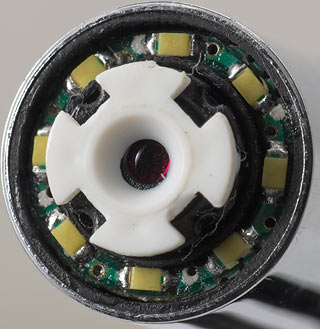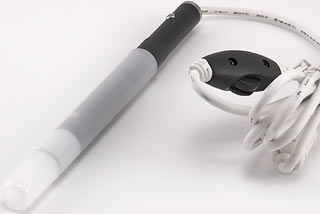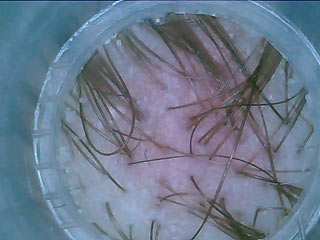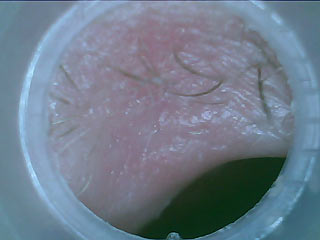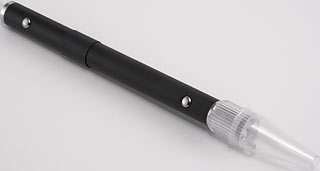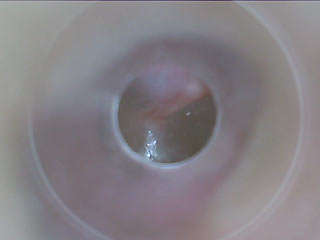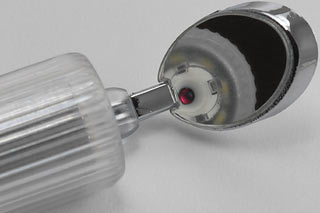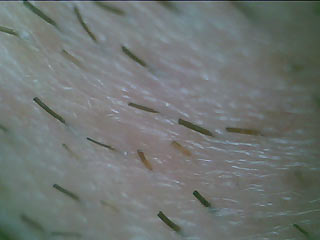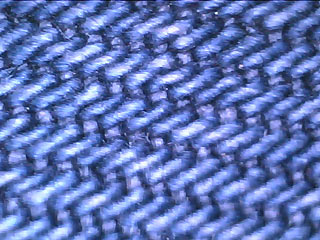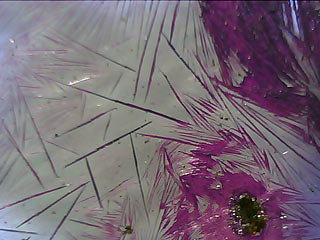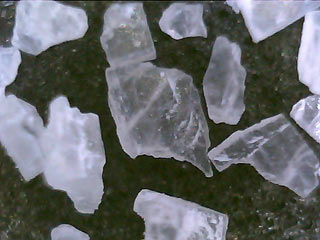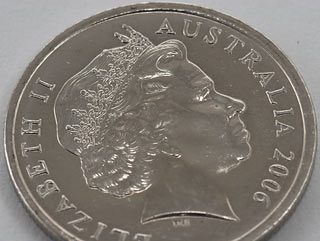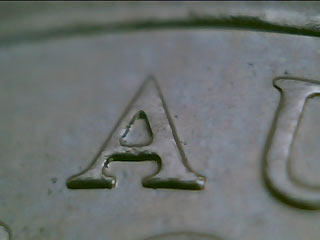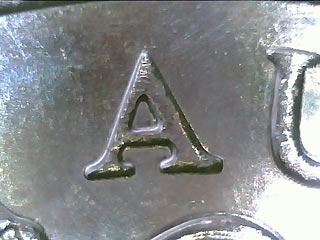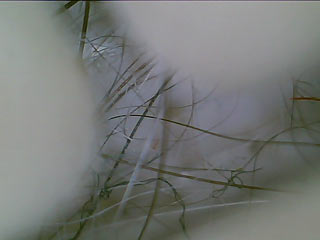
ETime Home Endoscope ("Digital Pen Camera")
Review date: 12 December 2007 Last modified 03-Dec-2011.
An endoscope is a thin viewing device, suitable for being poked into places where the human eye cannot, and possibly should not, otherwise see.
Since it's likely to be dark... in there, endoscopes usually have some sort of illumination device built in. The more sophisticated kinds of endoscope shoot light out of the same lens the user looks through. The common otoscope, for peering into ears, is the simplest example of that idea.
Endoscopes are useful for all sorts of things, but they're also usually rather expensive. Endoscopes that incorporate a camera so you can hook them up to a TV or computer are, generally speaking, more expensive again.
And then, there's this one.
It's the "eTime-home-endoscope" from Able Eye Device Co. of China, and here in Australia you can buy it (under the inventive name "Digital Pen Camera" - which, to be fair, is what's printed on the label on the plain white box) from Aus PC Market, for only $AU99 including delivery anywhere in the country.
(Australian shoppers who'd like to buy one right now can click here to do so.)
Electronically speaking, the eTime Digital USB Home Pen Endoscope Camera Thing is just a webcam. You plug it into your PC via a normal USB cable (about 1.4 metres, 4.6 feet, in length), and it comes with driver software that gives you the same sort of basic-but-functional control applications that you get with any dirt cheap basic webcam.
There's a program for capturing still images and video, there's a TWAIN driver; it only comes with WinXP and Win98/ME drivers, but the box has a Windows Vista sticker on it, so I presume either the XP driver works with at least 32-bit Vista, or you can get a Vista driver some other way, since the camera's based on a standard Vimicro VC0323 chipset. This probably also means that you can use the endoscope with Linux, since the VC0323 appears to be one of the six billion webcams supported by the untiring Michel Xhaard's suite of drivers.
And the eTime camera will also focus to infinity perfectly happily, so in a pinch you can use it for any ordinary webcam application.
But that's where the normal stuff ends.
This camera really is pen-shaped. Its sturdy aluminium casing (which is solidly packed with electronics in the middle, so it gets a bit warm in use) is a shade over 14 centimetres in length - topping out at about 144mm when the lens is wound out all the way to focus as close as possible. And it's only 12.2mm (0.48 inches) in diameter, except for a ring of heat-shrink tubing that slides freely up and down the casing. The heat-shrink is there to help hold on the tip fittings, of which more in a moment. There are also a couple of little shiny buttons on the side.
The buttons both do the same thing. Like the button on the top of a normal webcam, they let you grab a still frame. There are two of them because one will be covered when you're using one of the standard tips - or may just be inaccessible because the camera's deep inside... something.
The buttons aren't actually tremendously useful at the best of times, because if you're using the endoscope in extreme close-up mode - which is its strength - pressing the button will shake the camera and spoil your photo. But you can use the driver applications to do the same thing with a mouse-click, and you'll probably have a hand free to do that.
If all you need is a webcam-type device that can take very close-up pictures, you can use almost any ordinary webcam with manually adjustable focus. The further out you screw the lens on a simple camera, the closer it'll focus. Most adjustable-focus webcams can thus be made to focus on things only barely in front of the lens.
There are two problems with this, though.
First, ordinary webcams usually have a quite wide-angle lens, because they're meant to be used for stuff like videophone calls. For ordinary webcam applications, you want a wide enough field of view that the camera on top of your monitor will be able to see you, without making you sit in exactly one tightly defined spot.
For this reason, wide-angle lenses are selling points for webcams. They often boast a horizontal field of view of around 90 degrees. That's quite huge - it's about the same as a bug-eyed "18mm" lens on a 35mm camera.
For extreme close-ups, though, a wider field of view means you need to focus closer to get a given level of magnification. If you want to fill the whole image with something the size of a small coin, a 90-degree lens will have to be virtually touching the subject.
And this leads us to the second problem with close-focus webcams: They usually don't have an integrated illuminator.
Some webcams do have little LED lights built in, but most of them don't, and even if you do get an inbuilt illuminator, you'll find that it's not designed to light up things right in front of the lens. The result is that when the lens is really close to the thing you're looking at, it'll cast a shadow on it.
It's still possible to take surprisingly great-looking super-macro pictures with a webcam; here are a bunch of them on Flickr (probably including some that're actually webcam-through-a-microscope shots), and here's some more information. With lots of ambient light, or a flashlight shining in from the side, or paper or foil reflectors stuck onto a built-in LED illuminator, it can be done. But it's a pretty long way from being easy.
The eTime endoscope does not have either of these webcam problems.
First, its field of view is quite narrow, by webcam standards. I measured the horizontal field of view as about 25 degrees, which is about the same as an 85mm lens on a 35mm camera.
And, more importantly, the eTime camera has an illuminator.
Here's the business end of the eTime camera. It's not fancy enough to be able to throw illuminating light straight out of its viewing lens, but it gets pretty close to it with this ring of eight tiny surface-mount white LEDs (they look yellow when they're not turned on) around the lens.
There's a little thumbwheel doodad in the USB cable, close to the camera, that lets you adjust the brightness of the LEDs from zero to maximum. They're not terribly bright at the best of times - a modern single-5mm-LED pocket penlight has all eight of 'em beat - but they're good enough for super close-ups, which is the whole point of this camera.
If you want a really extreme close-up - absolute minimum focus distance is about 9mm from the lens - then the lens-surrounding illuminator still doesn't quite work, because the screwed-all-the-way-out lens will still cast a tiny shadow.
To mitigate this problem, and also to protect the lens, the camera comes with attachments that slip over the end.
This is, if you ask me, the most disturbing-looking of them.
It looks like nothing so much as a tampon applicator, and it slides over the whole front half of the camera. The tip extends a bit less than an inch in front of the lens.
The tube acts as a diffuser for the illuminator LEDs, and also reflects in some of the light that'd otherwise be lost out to the sides of the camera's field of view. But it also prevents you from focussing to minimum distance - well, unless you want your focus point to be inside the tube, anyway.
Even with this restricted focal distance, though, you can still get pretty darn close to a subject.
Here, by way of a gentle introduction to the rest of this page, is a shot of my scalp, taken through the tube attachment.
As you can see, the tube significantly vignettes the image. But you can still see plenty of stuff.
You can also still focus the camera when you've put one of the attachments on it, because the lens has four little notches spaced around it, and each of the attachments has teeth that click into those notches.
The tooth-in-notch connection is not very firm. If you don't want the attachment to stay in your ear when you remove the camera, you're going to need to slide that ring of heat-shrink tubing up so that it friction-fits under the base of the attachment. But it still works quite well.
The tube attachment is obviously meant to be stuck in orifices...
...so here, inevitably, is a view up my nose.
But wait. There's more.
This cone attachment looks like the cone on an otoscope (it, and the other small standard attachment, comes in a little sealed pouch like any number of other small surgical devices), and is intended for the same purpose.
It's got a smaller hole in the end than the tube attachment, so you can only clearly see a little circle in the middle of the view. In still shots this is pretty lousy, but it's quite adequate...
...for motion video.
(The endoscope, by the way, does not have a microphone. Be thankful for small mercies.)
The software that comes with the endoscope lets you capture AVI-format video clips. And, according to the ancient tradition of cheap webcam software, these clips are absolutely enormous. The capture software does at least save YCbCr-4:2:2-encoded video rather than just a string of monstrous pure RGB frames, but it more than makes up for this by padding out every video file to at least a hundred megabytes in size.
This isn't, fortunately, a big deal. It's easy to squish the AVIs down with VirtualDub or something (if you use the "Direct Stream Copy" option for the video in vDub, it'll strip the padding out of the file and leave you with the actual data without changing it).
You can of course also edit and compress the clips with Windows Movie Maker or any other basic software that takes your fancy. But if you keep them in their original format, be prepared to waste a lot of disk space.
If you want to take still pictures of some nook or cranny without the vignetting of the attachments, it's easy enough to use the camera with nothing on the end of it at all. You lose the ability to adjust focus on the fly, and any gunk in the object you're photographing will of course be able to get on the camera (you could avoid this by putting a layer of plastic wrap over the lens, at the cost of making focus adjustment even more annoying). But the results may well be worth it.
Here's another shot of the inside of my ear, this time with no attachment on the end of the camera.
(I found that a piece of clear vinyl tubing the same diameter as the camera tip also made a good attachment; it protects the camera a bit, it reflects the illuminator light inward, and if it doesn't stick out very far past the lens you won't see it in the picture at all.)
You also get this little angled mirror attachment with the camera. It, as you'd expect, lets you look out at right angles to the lens. This is handy not only for peering into awkward places but also for helping you keep the camera still, if bending the line of sight allows you to rest your hand somewhere that'd otherwise be impossible.
The mirror is (just) big enough that the lens can't see it. This shot of stubble on my chin was taken with the mirror attachment, but you wouldn't know to look at it.
The very close minimum focus distance makes the endoscope perfectly usable as a low-powered video microscope.
This is the fabric of my jeans, at less than maximum magnification.
These are some potassium permanganate crystals, grown on a microscope slide and lit from the side by a flashlight.
This is table salt, illuminated by the built-in LEDs with some help from that little paper reflector again.
You really don't need much more than a paper reflector to take pictures like this. You'll have a hard time if you're hand-holding the camera, but some unlikely contraption made out of discount-store spring clamps, or bits of wood and a clothes peg, will suffice to hold the camera nice and still over a subject.
Resolution
The eTime endoscope is alleged to have 640 by 480 ("VGA") sensor resolution, but I'm not sure whether it actually does.
It's normal for webcams of all sorts to allow you to wind up the resolution of their capture software to ridiculously high numbers, and that's the case here, too; the maximum resolution in the software is 1280 by 1024.
You should never expect to see any more detail if you select a resolution above what the specification sheet says the sensor can capture, so there's really very little reason to bother. You should, however, at least be able to get real detail at the specified sensor resolution. But as far as I can see, this camera delivers little to no extra detail beyond 320 by 240.
All of the pictures in this piece were captured at 640 by 480 - click the 320-pixel-wide versions to see the 640-wide originals - but I'm having a very hard time spotting any real image detail smaller than two-by-two pixels in the VGA-resolution images. Maybe here and there in the middle of the frame (photos from simple-lensed cameras like this are always soft around the edges), but it's really barely there at all.
(The capture software can save images as JPEGs or as uncompressed BMPs; all of the eTime camera's still images in this review started out as BMPs, then I saved them as JPEGs with less compression than the capture software uses, to preserve as much detail as possible. To tell the truth, though, I needn't have bothered; there's really no perceptible difference at all.)
You can get fake crunchy detail out of the endoscope by cranking up the "sharpness" slider in the capture software, but that doesn't do anything that sharpening the images in post-processing wouldn't also do. The detail is not actually there in the first place.
So perhaps the sensor isn't actually outputting 640 by 480. Or perhaps it is, but the tiny lens is letting it down.
Either way, this raises the question of how much actual image detail you're getting for your money.
For motion video, quite appallingly low resolution is entirely acceptable. Seriously expensive flexible endoscopes often have resolution no better than a 320 by 240 webcam, because they use a bundle of optic fibres to transmit the image. Each individual fibre in the bundle can only transmit one detail-less "pixel" of data, and light leaks between the fibres, too.
If you can move a low-res sensor around in real time and use a lens with decent magnification, though, you can still use a very low resolution device to examine tiny features of a human body, jet engine, safe you're not meant to be opening, or whatever.
This horrendous video clip, like the one further up the page, is only 320 by 240. If it hadn't been to start with, it would be after I uploaded it to Google Video, which (like YouTube) converts everything to 320 by 240 anyway.
But, subject matter aside, it looks fine. There's some pixelation when the camera pans from one of my tonsils to the other, but that wasn't there in the original - that's the Google Video codec throwing away data to reduce the file size. Even with the pixelation, though, the video's good enough for serious medical purposes. Only the fact that this camera isn't long and bendy prevents it from being just about as useful as a $US2000 fibre endoscope.
For still images, though, resolution matters. You can't wave the camera around to get an idea of what something looks like; you have to get all of the detail you need in that one frame in the first place.
So I was interested to see how much detail you could actually get out of the eTime camera. If it can't lay any more pixels across a given subject than a normal digital camera in macro mode (or a cheap webcam with its lens unscrewed), then its only useful purpose would be taking pictures in places where a normal camera cannot go. The rest of the time, you could just take a macro-mode shot and crop out the little bit out of the picture that the endoscope would have seen.
To check this out, I whipped out the macro lens for my Canon Canon EOS-20D. Which, as we'll see, doesn't actually perform much better for most purposes than the macro mode of many current compact cameras.
The coin in this picture is an Australian five cent piece. it's 19.41 millimetres in diameter (0.764 inches) - a hair bigger than a US penny, 1.4mm wider than a British 5p.
Here, I'm pointing my camera at it with my cheap plastic Phoenix macro lens and its screw-on life-size adapter focussing as close as it can. This gives something in the order of the 1:1 magnification (image inside camera the same size as the object being photographed) that technically defines true "macro" photography.
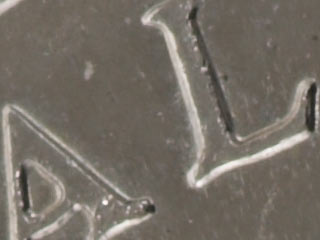
Here's a rotated, but otherwise unprocessed, 320-pixel-wide chunk out of the full-resolution version of the above image. The letters are less than 1.5mm in height.
It's noticeably soft - this is the limit of the lens's resolving power, especially at the very small f/22 aperture I was using to get maximum depth of field. So there'd be nothing gained by using a camera with a higher resolution sensor than the eight-megapixel sensor in the 20D.
(You can get more magnification out of just about any SLR lens with extension tubes, which I write about here. I tried it for this shot, and just got a bigger version of the same fuzz. I might have done a little better if I took more care to eliminate all vibration from the setup and opened the aperture a bit, but the difference wouldn't have been dramatic. This really is pretty close to the maximum detail you can wring out of one of these $US120 Cosina/Phoenix/Promaster/Vivitar/YumChaPhotographic 100mm macros.)
Even with this amount of fuzziness, though, there's still a pretty solid one pixel worth of data per two image pixels. And the camera's managing to lay about 200 pixels across the "A" on the coin. So, even being pessimistic, you're still getting a solid 80 pixels of real detail per millimetre.
It's easy to find a point-and-shoot camera with a similarly good macro mode. The superseded Canon PowerShot A700, for instance, manages 130-odd pixels per millimetre before you correct for fuzziness. After correction, it's still up there with the DSLR.
And you don't need a recent camera, either. Go back to the Nikon Coolpix 995 way back in 2001 (current eBay value: About $US75) and you'll find a nice sharp 19mm horizontal frame coverage from a camera with 2048 by 1536 resolution. That's 108 not-very-fuzzy raw pixels per millimetre, so 80 pixels of real detail per millimetre is still a quite likely figure.
Here's the endoscope's view of the same coin, at maximum magnification. I used a bit of folded paper, outside the shot, to direct light from the illuminator LEDs into the shadow cast by the lens.
The above image has very little depth of field; like a microscope, the endoscope at high magnification works best if it's perpendicular to the subject.
So here's another shot, this time straight down onto the coin. The endoscope's super-close minimum focus distance means it can fill the whole frame with a couple of those tiny letters - and in the 640 by 480 original, the "A" is about 280 by 260 pixels in size.
Because the 640-by-480 output of the endoscope camera has more like one pixel of data per four image pixels, though, those great big letters on the coin do not actually cover as many pixels as you might think. The real image detail covering the A is maybe like 140 by 130 pixels.
The DSLR shot is less noisy, too. So would be a shot from a compact camera, as long as it was only using a low ISO sensitivity.
But, even taking all this into account, the eTime endoscope is giving a very good account of itself. This little $AU99 camera-for-sticking-up-your-nose actually can deliver detail at least comparable with that of a proper macro lens on an SLR camera, or the macro modes of the better point-and-shoot cameras. It's no good if you want to cover an image area the size of a postage stamp at something like a hundred pixels per millimetre, but for microscope applications it holds up quite well.
Overall
If you've ever felt that the world could really do with a fullscreen action video of you trimming your nose hair, this is the device that'll make your dream a reality.
More practically, it really will let you take pictures or video of just about anything you could poke a pen into.
Damp organic places are the obvious targets, but there are all sorts of other possibilities. Engines, locks, wall cavities, you name it. Once you've got the thing in your hand, applications suggest themselves.
"I wonder if there's crud between the keys of my keyboard?"
"Yep!"
Devices that let you do all this and more have, as I said, been available for quite a while. But an endoscope with these kinds of features, for only $AU99 delivered, really is something of a breakthrough.
Recommended.
Australian shoppers can buy the eTime Home Endoscope from Aus PC Market for $AU99
including delivery anywhere in the country.
Click here to order!

